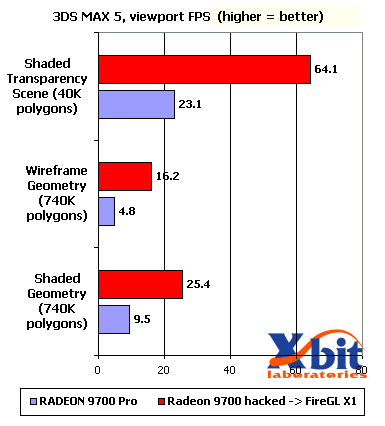Het hackcircus rond de R300-chip van ATi gaat onverminderd door, zo zien we bij X-bit Labs. Eerder al bleek een Radeon 9500 door een beetje creatief te solderen te veranderen in een Radeon 9700. Een aantal Russische techneuten is er nu in geslaagd zowel een Radeon 9500 als een 9700 om te toveren in de professionele varianten van de R300 VPU. Door een aantal pinnetjes op de core om te solderen, het bios van de kaarten te flashen en uiteraard de juiste drivers te gebruiken, slaagde men er in van de Radeon 9500 een FireGL Z1 te maken en de Radeon 9700 te veranderen in een FireGL X1. Na de hack werden de kaarten inderdaad herkend door het systeem als hun professionele broeders, en kon een spel als Serious Sam via de OpenGL-driver gespeeld worden. Benchmarks in 3DSMax5 wezen uit dat de kaarten met hun nieuw verworven identiteit een stuk harder konden werken:
As is known, the resistors positioning on the wafer of ATI R300 chips determines the possibility to reprogram their DeviceID.By moving the resistor of your RADEON 9500 and by reflashing the RADEON 9700 BIOS into it you will get the opportunity to reprogram the DeviceID from 4144 (DeviceID of RADEON 9500) into 4E44 (DeviceID of RADEON 9700). So, this is how the card is turned into a fully-fledged RADEON 9700.
However, this resistor is not the only one of the chip wafer. The resistor next to it has also been placed specifically there not for nothing. We supposed right away that it is responsible for another opportunity to change the DeviceID, so that by resoldering it we could get a professional adapter from FireGL X1, Z1, etc.
[...] Here are some results for your reference taken from the Benchmark directory of 3ds max 5 distributive. We are going to compare RADEON 9700 modified into FireGL X1 against RADEON 9700 Pro:

